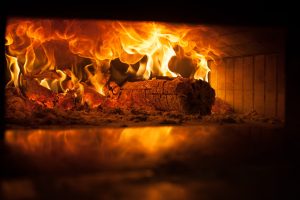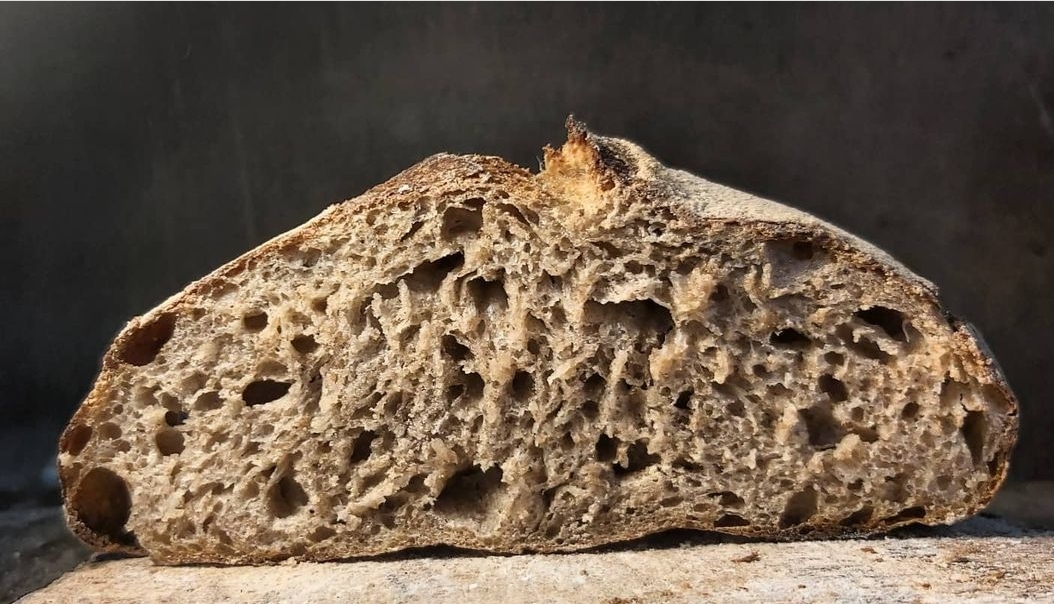At Riot Rye Bread School we bake with an Alan Scott designed woodfired oven which we built in 2011.
Our unique woodfired oven is a retained heat masonry oven which means that there is no fire lighting in the oven during the baking. All the energy for baking is gained from a fire lit in the oven prior to baking and the heat from that fire is stored in the masonry. The oven is highly insulated and the energy remains within the oven mass until it is used up through baking.
When baking, the oven works primarily through radiation. The energy stored in the masonry radiates from it, passing through the crust and bakes the bread quickly. This allows the bread to be baked at high temperatures.

Secondly there is conduction, where the loaf is sitting on the hearth of the oven and the heat stored there penetrates the dough; expanding the gases and giving volume to the loaves through what is known as ‘oven spring’.
Thirdly there is convection, where the air temperature within the oven bakes the crust.
During our classes we also bake off some bread in a small, simple plug-in domestic oven. We can see that no matter what type of oven, we can still bake beautiful and delicious sourdough breads.

At home in my house, I have a regular domestic fan oven. This is my preferred oven to bake with when I’m baking off one or two large miche style sourdough loaves. These loaves need an initial high temperature with plenty of bottom heat. They also require steam and a uniform heat source. When baking off one or two loaves, it’s easier for me to control these elements in my small domestic oven than in my large Alan Scott oven.
As home bakers – baking in a domestic oven, we will either bake our loves covered in a Pyrex dish (as we do in The Common Loaf Recipe), a Dutch oven, Challenger Bread Pan or cast iron pot. This method requires no extra steam to be added to the oven during baking.
You can see how to utilise a Pyrex dish in our video for The Common Loaf Sourdough recipe here.
Alternatively we can bake our loaves directly on a baking tray or stone. This will require us to add steam to the baking chamber. We’ll look at how we do this later in our deep dive.
I find using an inverted Pyrex dish with a tea towel in it (a method we created a number of years ago for The Common Loaf recipe, to be the simplest and most effective way of proving and baking bread in a domestic oven.
A 3 ltr Pyrex is suitable for between 700g and 850g of dough, giving a good sized family loaf. Some other reasons for using a Pyrex dish to bake in are:-
- It is a relatively cheap and accessible container to bake and prove our dough in compared to a cast iron pot or Dutch oven.
- We can bake the bread in the same container as we prove it in.
- We can see the loaf baking without having to open the dish or pot.
- The dish can be put into the oven cold, so that we don’t run the risk of burning our hands when trying to score the dough before baking.
- We can leave the lid on or off to create a thin or thick crust on the finished loaf.
- We don’t have to add extra steam into our oven. All the steam from baking the loaf is trapped in the Pyrex and utilised to give a crisp, caramelised crust. The trapped steam also keeps the scoring open, allowing for good oven spring and resulting in a nice soft open crumb.
- We can produce great loaves of bread from any oven.

When baking in a Pyrex dish, Dutch oven or cast iron pot, we usually bake at relatively high temperatures of 240-250°C. This is because the heat must travel through the glass or iron before it reaches the dough.
Baking on a baking tray, tile or stone
When baking buns or other breads such as pans, batards or large sourdough loaves (miches), these will usually be baked on a baking tray, tile or stone. For these types of breads, we will bake at slightly lower temperatures of 210-220°C.
Usually when I am baking a pan, batard or large miche I will:-
Preheat the oven to 240°C with a roasting dish on the bottom of the oven and a heavy duty baking tray or pizza stone on a shelf in the middle of the oven.
Boil a kettle of water.
Remove the preheated baking try from the oven. Load the proved dough onto the baking tray, score the dough and place back in the oven.
Pour 2-3mm of boiling water into the preheated roasting tray on the bottom of the oven. This water will immediately begin to boil, producing steam for a couple of minutes inside the oven.
Close the oven door.
Turn down the oven from 240°C to 220°C.
Bake for the first 20 mins at 220°C, with the fan off, then turn the temperature down to 210°C for the last 20 mins.
If we wish to create extra steam in the oven, we can also use a mister to spray water into the oven. To do this, about 2 mins after we have loaded the dough into the oven and poured water into the roasting tin and closed the door again. Open the oven door and quickly mist the inside of the oven with the spray on a fine setting (the water can also land on the dough).
Close the door and do not open again for approximately 20 mins, otherwise all the energy used to create the steam will be lost.
Note: I wouldn’t recommend spraying water into a gas oven.
If using a fan oven we can drop the above temperatures by about 10°C.
If we wish to bake our bread at 220° C, preheat the oven to 230-240°C.
When we open the oven door, load the cold dough and add steam to the oven, the temperature of the oven will fall by 10-20°C. If we only preheat the oven to the temperature we wish to bake at, say 220°C, the oven will be below temperature for the first 10 mins or so (as the oven heats back up again).
It is more efficient to preheat the oven to 230-240°C, load the dough, add water for steam, close the door and then turn the thermostat down to 220°C.
For bread rolls and buns, drop the oven temperature by 10-15°C.
Bottom heat
To achieve a good firm crust on the base of our loaves and to help with oven spring it can be useful to use a baking stone/tile in our oven. The preheated stone/tile will provide what is known as bottom heat. This source of heat directly below the dough can help with achieving good volume in our bread. Energy is also transferred into the bread through conduction, like in our Alan Scott oven.
A good source of bottom heat is also beneficial when baking off high hydration dough or dough that is very well proved. The direct source of heat beneath the dough sears it. This inhibits the dough from spreading out too much in the oven before the gases expand and creates good volume in the finished loaf.
It’s important to make sure that the baking stone/tile is saturated with heat whilst preheating the oven. Otherwise a cold stone can be detrimental to the bake causing the dough to stick to the stone/tile, allowing the dough to spread prior to rising and leaving a soft bottom on the loaf.
Hope you found this useful and please comment on this topic below. You can subscribe to our online baking community to send your baking queries and suggestions for future topics to Joe.
In Part 3 of our Deep Dive into Temperature, we will talk about knowing when your loaf is fully baked.


Leave A Comment